Gardening in urban areas and on patios means less space. Using pots and containers can help keep your garden organized while giving you more room to grow.
Growing bulbs in pots is a great way to add a burst of spring beauty to your patio whether you are in a condo or an apartment. In addition, the pots protect the bulbs from squirrels and voles which may dig up or munch on bulbs planted in the ground.
Timing
Timing is very important when planting bulbs. If you live in an area with a distinct winter, typically USDA Zone 7a or colder you will plant bulbs in the fall for spring flowers.
In Zones 3-7a plant bulbs around the time you plant garlic. (Check out my article on growing garlic) For Zone 6b that’s late October.
If you live in USDA Zone 7a - 10 then you will need to give your bulbs a chill period. An extra refrigerator works well. Put them in the vegetable crisper drawer for 10 to 16 weeks. (Don’t mix bulbs and fruit together!)
If you don’t have room in your fridge you need to find a spot that has temperatures between 35 F to 45 F.
What Type of Pots
Bulbs do not like soggy feet. You can use a variety of pots - clay, plastic or wood.
Make sure the container you choose has plenty of drainage holes. Feel free to use a drill and make a few more.
You can also use grow bags that drain naturally.
How To Plant Fall Bulbs
Bulbs that flower in spring are planted in the fall. These include daffodils, hyacinths, and tulips.
Start with 3-4 inches of pebbles at the bottom to allow for good drainage
Fill your container halfway with potting soil. You may need to adjust this so the bulb can be planted to three times its height. For tulips and daffodils that’s 5-6 inches and 3-4 inches for crocus.
Bulbs in pots can be safely planted a bit closer together and more shallowly than in your outdoor garden.
Place the bulbs in the soil with the pointy end facing up.
Cover the bulbs with potting soil.
Water well and then don’t water again till spring.
Protect Over Winter
Place your pots in a cool place. If you have a garage or unheated basement place them in a dark cool corner for winter. An outdoor garden shed works well too.
I have a storage unit in the basement of my building. This year I have placed a pot of bulbs there and put a note on my fridge to remind me to check on them! I’ll keep you posted!
I have also heard of people who place the entire pot in an extra fridge for 8-10 weeks. This is basically what people in the south do when chilling their bulbs.
You can also place them on a patio outside with some protection. Several pots together may give each other protection if your winter is not too cold.
They can deal with the winter cold but too much wet will cause the bulbs to rot. For me, I have the upstairs neighbor’s patio above mine so that provides some shelter. I also provide them with some wind blockage.
Monitor In Spring
Keep an eye on the weather in late winter. When your bulbs start to send up green shoots it’s time to move them to a sunny spot.
How To Plant Summer Bulbs
Summer bulbs aren’t quite as well-known or popular but be sure to give them a try! Gladiolus and lilies are both easy and fun to grow. There are even summer daffodils that can be planted in spring.
One advantage is you don’t have to winter them over. These types flower in later summer which gives you a fresh season of pretty colors.
These bulbs have a longer growing season so make sure to use larger containers. Choose pots that have several drainage holes or grow bags.
Water summer bulbs regularly during the growing season. Keep in mind containers dry out faster than garden soil.
Fertilize your plants when they start to bud with a good organic fertilizer such as fish emulsion.
Best Bulbs To Plant
Any bulb can thrive in a pot or grow bag. However, miniature daffodils, hyacinths, and crocuses are considered the best for beginners. You can order bulbs online or buy them at your local nursery.
Author, Ame Vanorio, is a lifelong gardener, environmental educator, and founder of Fox Run EEC








Controlling humidity in the home is important for your plant’s health. High levels of humidity promote bacteria, molds, and mildew. Not enough humidity causes plants to dehydrate quickly and possibly suffer cell damage.
When I moved from Kentucky (Zone 6B) to Wisconsin (Zone 5A) last year I realized how important humidity was. Last winter the humidity in my apartment dropped from a summer average of 60% to a winter average of 16%.